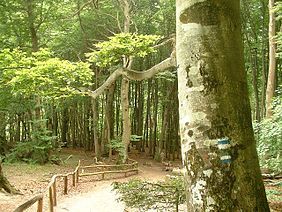Jasmund National Park
| Jasmund National Park | |
|---|---|
| Nationalpark Jasmund | |
|
IUCN category II (national park)
|
|

Cliffs and coastline in the national park
|
|
| Location |
|
| Nearest city | Sassnitz, Stralsund |
| Coordinates | 54°33′07″N 13°37′23″E / 54.552°N 13.623°ECoordinates: 54°33′07″N 13°37′23″E / 54.552°N 13.623°E |
| Area | 30 km2 (12 sq mi) |
| Established | 12 September 1990 |
| Primeval Beech Forests of the Carpathians and the Ancient Beech Forests of Germany | |
|---|---|
| Name as inscribed on the World Heritage List | |
 |
|
| Type | Nature |
| Criteria | ix |
| Reference | 1133bis |
| UNESCO region | Europe |
| Inscription history | |
| Inscription | 2007 (31st Session) |
| Extensions | 2011 |
The Jasmund National Park (German: Nationalpark Jasmund) is a nature reserve on the Jasmund peninsula, in the northeast of Rügen island in Mecklenburg-Vorpommern, Germany. It is famous for containing the largest chalk cliffs in Germany, the Königsstuhl (German = "king's chair"). These cliffs are up to 161 m (528 ft) above the Baltic Sea. The beech forests behind the cliffs are also part of the national park.
Consisting of only 30 km2 (12 sq mi), this is the smallest national park in Germany. The park was founded in 1990 by the last government of East Germany (GDR) prior to the German reunification.
On June 25, 2011 the beech forest in the park was added to UNESCO World Heritage Site as an extension of the Primeval Beech Forests of the Carpathians and the Ancient Beech Forests of Germany.
The chalk cliffs face constant erosion. With every storm, parts of the cliffs fall, including rocks and fossils of sponges, oysters and sea urchins.
The most majestic part of the cliffs is the Königsstuhl (English: king's chair) which stands at 118 m (387 ft). One of the most scenic and best known of the chalk outcrops, the Wissower Klinken, collapsed into the Baltic Sea on February 24, 2005, in a landslide caused by spring-thaw weather conditions.
Because of the special geological characteristics of the Jasmund National Park, it is home to many rare plants and animals.
...
Wikipedia
